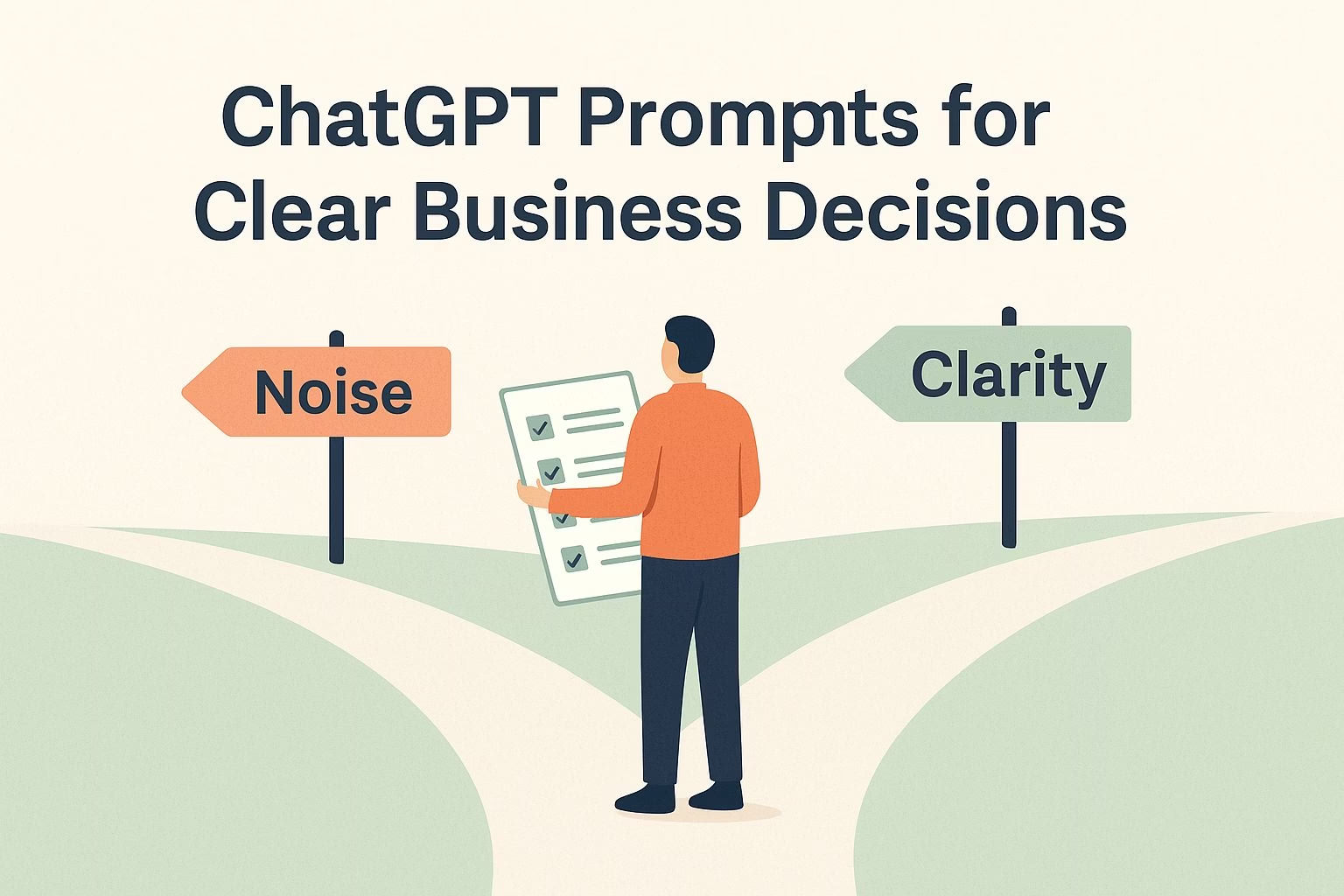5 ChatGPT Prompts That Will Sharpen Every Business Decision You Make
We all reach that moment. Too many ideas on the table. Conflicting opinions pulling in opposite directions. You want to move, but every choice feels like a risk.
That’s not a lack of motivation. That’s decision fatigue. It creeps in when the signal gets drowned in noise.
This article isn’t another generic productivity list. It’s a toolkit built around five prompts, each one crafted to help you get clarity fast using ChatGPT.
These prompts work especially well if you run a business, lead a team, or feel overwhelmed by daily trade-offs. They don’t give you answers. They help you ask the right questions.
I’ve used some of these exact prompts to make real decisions about which offers to drop, which partners to say no to, and which project was actually worth the time.
And I’ve seen others use them to avoid expensive distractions disguised as “exciting new opportunities.”
Whether you’re deciding what product to launch, who to hire, or what strategy to pursue, these prompts will show you what actually matters, and what you can safely ignore.
1. Define Your Victory Condition
When you don’t know what “winning” looks like, everything becomes urgent. Every idea feels tempting. Every distraction looks like a possibility. That’s how teams burn out and founders stall.
This prompt forces you to define success in one sharp sentence.
Prompt to use:
“Using everything you know about my vision… state in ONE sentence the outcome that makes every future decision an automatic yes.”
This is not about setting a goal. It’s about locking in a filter. Think of it like setting the coordinates on your GPS; every road not pointing toward it becomes noise.
Example:
Let’s say you’re running a SaaS product for freelancers. Your victory condition might be:
“In 12 months, we want 5,000 paying users generating $300k ARR with 70% retention.”
Now, when someone pitches you a podcast tour or a partnership with influencers, you can ask:
Does it help hit that number?
If not, it’s a distraction.
Use this when:
-
You feel pulled in too many directions
-
You’re about to make a big hire or investment
-
You’re planning a new product or feature
2. Get 3 Critical Perspectives
You’re too close to the problem. Most of us are. That’s why this prompt uses ChatGPT to simulate three versions of you:
-
Your toughest critic
-
Your biggest supporter
-
Your future successful self
Prompt to use:
“Role-play these 3 perspectives grading this decision on: value alignment, sustained joy, and compounding upside.”
It’s fast. It’s focused. It gives you contrast. You’ll often find one version of you sees something the others don’t.
Example:
You’re considering raising prices on your subscription service. Here’s what each version might say:
-
Toughest critic: “This might drive away loyal users who supported you early.”
-
Biggest fan: “You’ve added so much value, this is overdue.”
-
Future self: “This gave you the margin to scale support and grow with confidence.”
When you look across those views, you’ll see more than just logic. You’ll see alignment.
Use this when:
-
You’re second-guessing a gut decision
-
You need perspective without asking a dozen people
-
You’re tempted to follow the crowd
3. Calculate Real Costs
Every decision comes with a hidden bill. Time, money, attention, when you say yes to one thing, you’re saying no to something else.
This prompt helps you visualize what that tradeoff actually looks like.
Prompt to use:
“Calculate the opportunity cost of saying YES. Show: lost revenue, neglected relationships, reputation risk.”
This is about subtraction, not addition. Most people look at what they’ll gain. Few stop to consider what they’ll lose.
Example:
You’re thinking about building a second product. On the surface, it seems like a win. But when you ask ChatGPT to calculate the cost of saying yes, here’s what might show up:
-
You’ll delay current feature updates by 3 months
-
You’ll need to split your team’s focus, increasing churn risk
-
You’ll lose $15k/month from paused sales campaigns
-
You’ll spend less time with top customers, risking long-term loyalty
Now it’s not just “build another product or not.” It’s: “Is this worth more than what I’m giving up?”
Use this when:
-
You’re tempted to chase two priorities at once
-
A new idea sounds exciting but has an unclear impact
-
You want to defend your time with real data
4. Pre-Name Future Distractions
Not every threat looks like a threat. Some show up disguised as praise, praise, or shiny collaborations.
This prompt helps you prepare for them now, before they show up and derail your focus.
Prompt to use:
“List 3 seductive distractions I’ll face this year. Write the exact sentence I’ll use to decline each.”
It’s a simple shift: don’t just react to distractions, pre-decline them.
Example:
You run a high-performing online course and want to grow it without burnout. Here’s what ChatGPT might help you write:
-
Distraction: “Invite to speak at a conference that looks good but doesn’t target your audience.”
Response: “Thank you for the invite, but I’ve committed this quarter to deep work and customer outcomes.” -
Distraction: “Offer to co-create a new product with someone outside your niche.”
Response: “It’s a great idea, but I’m focused on scaling what’s already working this year.” -
Distraction: “Chance to rebrand everything because of one bad review.”
Response: “Our direction is clear, and one review doesn’t change our roadmap.”
Use this when:
-
You’re heading into a launch or new growth phase
-
You’re easily tempted by shiny objects
-
You want to set boundaries ahead of time
5. Build a 90-Day Scoreboard
Most goals die in the fog. You start strong, then lose track of what’s working.
This prompt turns your focus into a visible scoreboard, giving you one metric to track, weekly reviews to reflect, and a system to adjust fast.
Prompt to use:
“Design a 90-day scoreboard with ONE key metric. Include:
• A weekly 10-min review
• 3 reflection questions
• An action if the metric dips.”
It’s not about tracking everything. It’s about tracking the one thing that reflects actual progress.
Example:
Say you’re growing a paid newsletter. You might choose:
Key metric: New subscribers per week.
Your scoreboard setup:
-
Weekly review: Every Friday at 4 pm
-
Reflection questions:
-
What drove this week’s results?
-
What felt off or heavy?
-
What should we double down on?
-
-
Action if the metric dips: Run a quick email campaign to your free list with a limited-time offer
In 10 minutes a week, you stay grounded in results, not noise.
Use this when:
-
You want momentum without micromanaging
-
You need a system to catch drift early
-
You’re building something that requires consistency
Make Decisions Like a CEO, Not a Crowd
Clarity doesn’t come from asking more people. It comes from sharper prompts. With these five tools, you cut through the fog:
-
Define your victory condition
-
Simulate 3 critical perspectives
-
Reveal the hidden costs
-
Pre-decline distractions
-
Track progress with a scoreboard
You don’t need another round of advice. You need sharper filters. Whether you’re scaling a business or just trying to focus, these prompts help you spend your energy where it matters.
Tools like ChatGPT make this process faster, but clarity is still a choice. One decision at a time.

